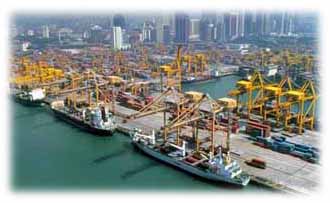The Shipping Container

Singapore is home to the world’s busiest port. In 2005, over 423,267,000 tonnes of cargo passed through. Much of its success is due to its geography: it's located along the Straits of Malacca, on the main shipping route between Asia and the West. But Singapore also seized the opportunities provided by containerisation. Singapore deepened its harbor to allow giant bulk carriers. It installed infrastucture such as gantry cranes and automated its operations. Each year, Singapore sees more than 20 million shipping containers past through its port. Amazingly, fewer than 10 of these containers are misplaced or damaged.
Here are excerpts from economist Virginia Postrel's review of Marc Levinson’s book The Box: How the Shipping Container Made the World Smaller and the World Economy Bigger:
Just as the computer revolutionized the flow of information, the shipping container revolutionized the flow of goods. As generic as the 1's and 0's of computer code, a container can hold just about anything, from coffee beans to cellphone components. By sharply cutting costs and enhancing reliability, container-based shipping enormously increased the volume of international trade and made complex supply chains possible.
''Low transport costs help make it economically sensible for a factory in China to produce Barbie dolls with Japanese hair, Taiwanese plastics and American colorants, and ship them off to eager girls all over the world,'' writes Marc Levinson...
For consumers, this results in lower prices and more variety…
When the first container ship set sail 50 years ago, businesses and regulators treated distribution not as a single process but as a series of distinct modes: ships, trucks and trains. Every time the transportation mode changed, somebody had to transfer physically every box or barrel.
''By far the biggest expense in this process was shifting the cargo from land transport to ship at the port of departure and moving it back to truck or train at the other end of the ocean voyage,'' writes Mr. Levinson, a Wall Street economist and former economic journalist. This ''breaking bulk'' could easily consume half of the total cost of shipping.
Goods often had to wait in warehouses for the next stage. Those transfers and delays made shipping slow and schedules uncertain. They also created opportunities for damage, mistakes and more than a little theft. (Whiskey was one of the first products shipped by container because it was so subject to pilferage.) Different companies in different industries facing different price regulations for different goods handled each step.
Today, by contrast, ''you can call one of the big international ship lines, tell them to pick up your container in Bangkok, which is not a port, and tell them to deliver it in Dallas, which is not a port, and they will make the arrangements to get it to a port and get it on a ship and get it off at another port and get it onto a train or truck and get it where it needs to be,'' Mr. Levinson said.




0 Comments:
Post a Comment
<< Home